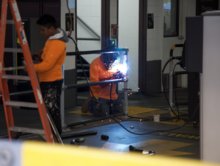
La fabricación de metales es la creación de estructuras metálicas mediante procesos de corte, doblado y ensamblaje. Es un proceso de valor agregado [1] que implica la creación de máquinas, piezas y estructuras a partir de diversas materias primas.
Por lo general, un taller de fabricación oferta por un trabajo, generalmente basándose en planos de ingeniería , y, si se le adjudica el contrato, construye el producto. Las grandes fábricas emplean una multitud de procesos de valor agregado, que incluyen soldadura, corte, conformado y mecanizado.
Al igual que con otros procesos de fabricación, comúnmente se utilizan tanto la mano de obra humana como la automatización . Un producto fabricado puede denominarse fabricación , y los talleres especializados en este tipo de trabajo se denominan talleres fab . Los productos finales de otros tipos comunes de trabajo de metales, como el mecanizado , el estampado de metales , la forja y la fundición , pueden ser similares en forma y función, pero esos procesos no se clasifican como fabricación.
La fabricación comprende o se superpone con diversas especialidades metalmecánicas:
Standard metal fabrication materials are:
A variety of tools are used to cut raw material. The most common cutting method is shearing.
Special band saws for cutting metal have hardened blades and feed mechanisms for even cutting. Abrasive cut-off saws, also known as chop saws, are similar to miter saws but have a steel-cutting abrasive disks. Cutting torches can cut large sections of steel with little effort.
Burn tables are CNC (computer-operated) cutting torches, usually powered by natural gas. Plasma and laser cutting tables, and water jet cutters, are also common. Plate steel is loaded on the table and the parts are cut out as programmed. The support table consists of a grid of bars that can be replaced when worn. Higher-end burn tables may include CNC punch capability using a carousel of punches and taps. In fabrication of structural steel by plasma and laser cutting, robots move the cutting head in three dimensions around the cut material.
Forming converts flat sheet metal into 3-D parts[4] by applying force without adding or removing material.[5] The force must be great enough to change the metal's initial shape. Forming can be controlled with tools such as punches and dies. Machinery can regulate force magnitude and direction. Machine-based forming can combine forming and welding to produce lengths of fabricated sheeting (e.g. linear grating for water drainage).[6] Most metallic materials, being at least somewhat ductile and capable of considerable permanent deformation without cracking or breaking, lend themselves particularly well to these techniques.[7]
Proper design and use of tools with machinery creates a repeatable form that can be used to create products for many industries, including jewelry, aerospace, automotive, construction, civil and architectural.
Machining is a specialized trade of removing material from a block of metal to make it a desired shape. Fab shops generally have some machining capability, using metal lathes, mills, drills, and other portable machining tools. Most solid components, such as gears, bolts, screws and nuts, are machined.

Welding is the main focus of steel fabrication.[8] Formed and machined parts are assembled and tack-welded in place, then rechecked for accuracy. If multiple weldments have been ordered, a fixture may be used to locate parts for welding. A welder then finishes the work according to engineering drawings (for detailed welding) or by their own experience and judgement (if no details are provided).
Special measures may be needed to prevent or correct warping of weldments due to heat. These may include redesigning the piece to require less welding, employing staggered welding, using a stout fixture, covering the weldment in sand as it cools, and post-weld straightening.
Straightening of warped steel weldments is done with an oxyacetylene torch. In this highly specialized work, heat is selectively applied to the steel in a slow, linear sweep, causing the steel to contract in the direction of the sweep as it cools. A highly skilled welder can remove significant warpage this way.
Steel weldments are occasionally annealed in a low-temperature oven to relieve residual stresses. Such weldments, particularly those for engine blocks, may be line-bored after heat treatment.
After the weldment has cooled, seams are usually ground clean, and the assembly can be sandblasted, primed and painted. Any additional manufacturing is then performed, and the finished product is inspected and shipped.
Many fabrication shops offer specialty processes, including :